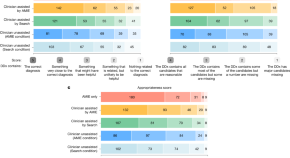Recent advancements in artificial intelligence have sparked significant interest in how machine learning models, particularly large language models (LLMs), can influence healthcare, particularly in the realm of differential diagnosis. With the successful deployment of models such as GPT-4 and AMIE, researchers have aimed to establish a framework for evaluating their efficacy in clinical scenarios. The intersection of technology and medicine has never been more critical, especially when human lives hinge on accurate diagnosis and timely intervention.
In a recent study detailed in a groundbreaking paper, researchers delved into the performance of these LLMs on a carefully curated subset of medical cases. While the direct comparison of top-10 accuracy metrics between GPT-4 and AMIE proved challenging due to varying human raters, the evaluation of a 70-case subset allowed for an automated metric analysis. Such metrics offer a glimpse into the reliability and potential of these AI models as diagnostic aids, essential for the future of medical practice.
The results revealed that AMIE outperformed GPT-4 in terms of top-n accuracy for n greater than 1, exhibiting a particularly pronounced advantage for n greater than 2. This suggests that AMIE not only identifies leading differentials but also expands the breadth and quality of possible diagnoses presented. This aspect is crucial in clinical environments where comprehensive information can significantly alter treatment plans and outcomes for patients.
Interestingly, for n equal to 1, GPT-4 demonstrated a slight edge over AMIE, although this difference lacked statistical significance. This finding challenges the notion that one model is unequivocally superior to the other, highlighting a nuanced landscape of AI performance and underscoring the importance of context in interpreting diagnostic results. While GPT-4’s marginal advantage may suggest reliability for single-diagnostic cases, the significant improvements noted in AMIE for multiple options illustrate the potential for enhanced patient care through more informed clinical decision-making.
Illustrating these findings, Figure 4 from the study provides a visual comparison of the percentage of differential diagnosis (DDx) lists that encompassed the final diagnosis for both models. The data indicated that both AMIE and GPT-4 yielded closely aligned trends when evaluated against 70 selected cases. Shaded areas in the figure denote the standard deviation across 10 trials, showcasing the consistency and robustness of findings across various iterations.
The emergence of automated metrics as a consistent measure of performance heightens the significance of these findings. Automated evaluation offers a scalable and repeatable method for assessing AI models, especially when human raters may introduce variability. By utilizing quantitative metrics alongside qualitative assessments, researchers can establish a more comprehensive understanding of how these models function in high-stakes environments like healthcare.
Moreover, the implications of these results extend beyond mere academic curiosity; they carry profound consequences for how medical practitioners will leverage AI technologies. The ability to generate comprehensive and accurate differential diagnoses can not only enhance the efficiency of diagnosing complex cases but also empower medical professionals with decision support tools that harness the vast amounts of clinical data available today. As healthcare increasingly intersects with artificial intelligence, the potential for improved patient outcomes appears promising, provided these tools can be effectively integrated into clinical workflows.
The research also emphasizes a critical need for continuous improvement and iteration within AI models. As data inputs and algorithms evolve, so too must the evaluation frameworks that assess their performance. Ensuring that these models remain relevant and effective in a rapidly changing medical landscape requires ongoing collaboration between healthcare professionals, data scientists, and AI developers. Such interdisciplinary collaboration can foster a sustainable ecosystem where innovative solutions are nurtured and responsibly deployed.
Looking forward, the study posits that the advances in diagnostic accuracy facilitated by models like AMIE impart a new urgency for the development of guidelines governing the use of AI in medicine. As trust in AI technologies solidifies, it is paramount that regulatory frameworks evolve in tandem to ensure that these tools maintain ethical standards and prioritize patient safety.
As the discourse surrounding AI in healthcare continues to grow, it is essential to navigate the challenges of implementation, including data security, bias mitigation, and user training. Addressing these challenges upfront will be instrumental in realizing the full potential of LLMs in clinical practice. With foundational studies such as this, the pathway toward integrating AI into healthcare looks increasingly viable, revealing a future where technology acts as an ally to medical professionals.
In essence, the advent of language models like AMIE and GPT-4 heralds a new chapter in medical diagnosis, one that embraces innovation while remaining anchored in the vital principles of care. The ongoing exploration of AI in diagnostics not only promises enhanced accuracy but also catalyzes transformative changes in how we approach patient care, diagnosis, and treatment across the healthcare spectrum. As we continue to delve into this intersection of technology and medicine, the potential for groundbreaking advancements only deepens, forging a path towards a more efficient and effective healthcare system.
In conclusion, the performance evaluations of AMIE and GPT-4 not only stimulate academic debate but also ask critical questions about the future of diagnostic practices in medicine. Their revelations regarding differential diagnoses emphasize the need for robust, AI-enhanced clinical tools that support, rather than supplant, human expertise. As research progresses, the synthesis of AI with human intuition and decision-making will invariably shape the future contours of healthcare, marking a pivotal moment in the integration of technology within medicine.
Subject of Research: Performance comparison of AI language models in differential diagnosis.
Article Title: Towards accurate differential diagnosis with large language models.
Article References:
McDuff, D., Schaekermann, M., Tu, T. et al. Towards accurate differential diagnosis with large language models.
Nature (2025). https://doi.org/10.1038/s41586-025-08869-4
Image Credits: AI Generated
DOI: 10.1038/s41586-025-08869-4
Keywords: AI, differential diagnosis, healthcare, GPT-4, AMIE, large language models, medical technology.




